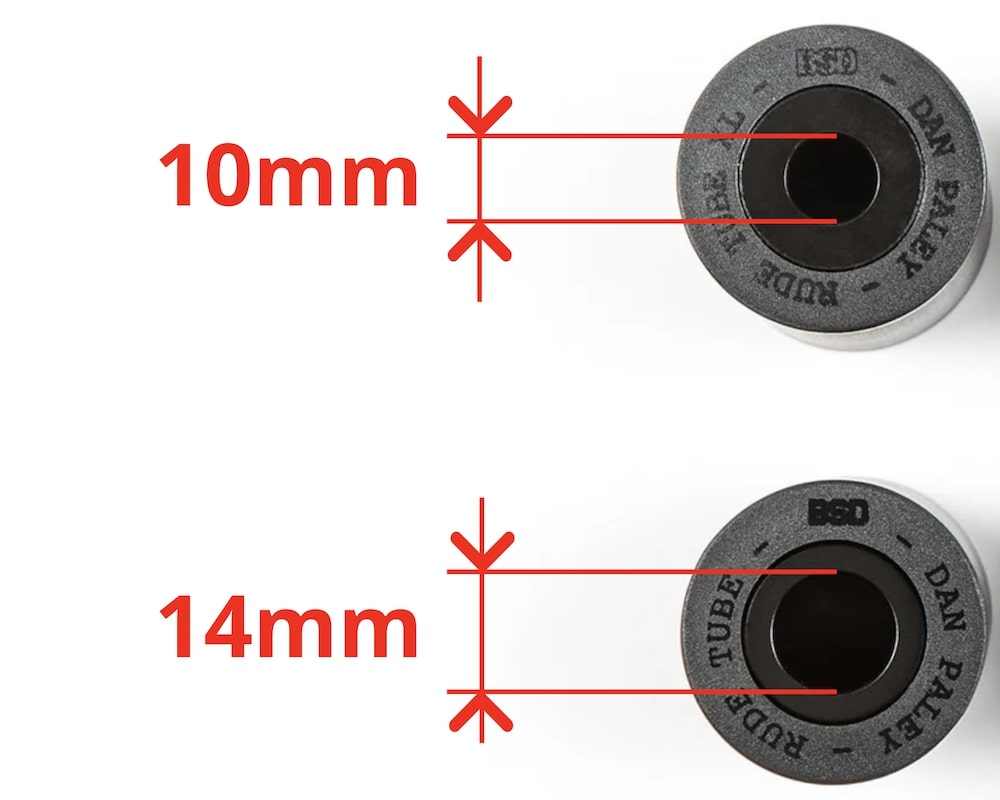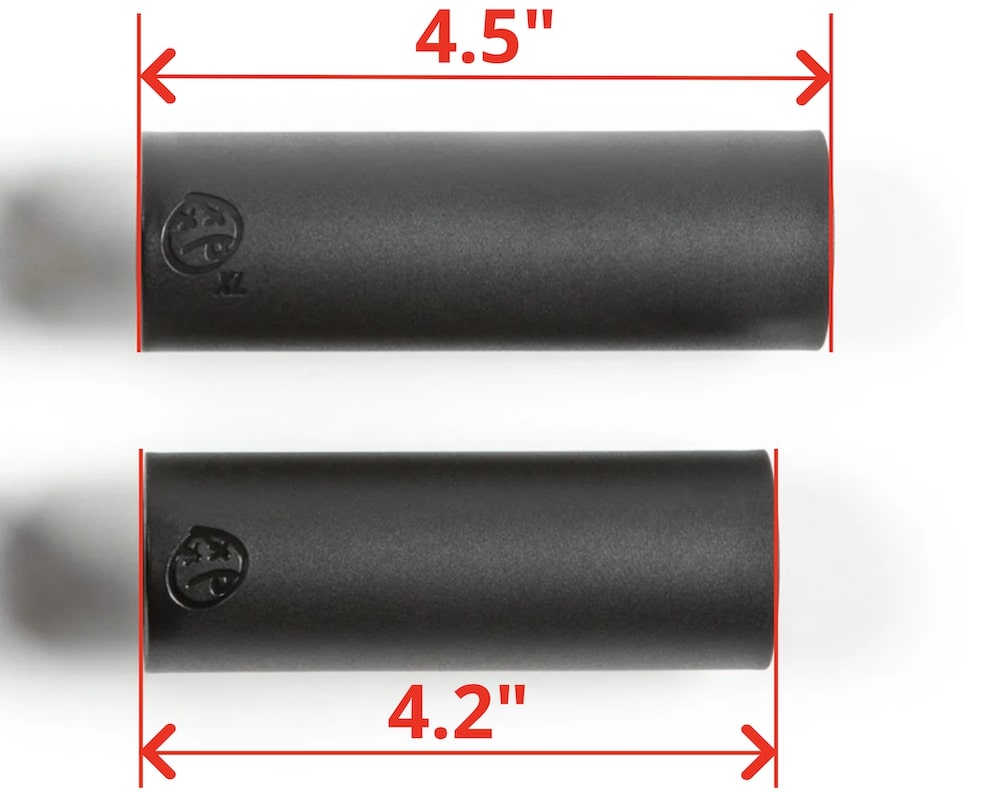Are you trying to figure out the right BMX peg size for you?
While the two measurements are the standard for all pegs, there’s another one that can make a big difference to how your grinds feel.
How Do I Know What Size Bike Pegs I Need?
| Peg size spec | Description |
| Axle hole | Front wheels have 10mm & rear 14mm axles |
| Length | Pegs can be anywhere from 4 – 5″ long |
You need to focus on two main measurements:
1. BMX Bike Peg Axle Hole

All modern BMX bikes have a front wheel with a 10mm axle and a rear wheel with a 14mm axle.
However, not all BMX pegs are axle-specific.
Meaning, many brands have universal 14mm pegs with a 10mm adapter (because it’s cheaper to make) to fit the front axle. (This also helps answer the “are BMX pegs universal” question.)
BUT!
That’s not always the case. Read the description before getting yourself a peg.
Some BMX brands put in the extra effort and create 10mm and 14mm pegs, so you don’t need adapters.
2. BMX Bike Peg Length

In the early days, BMX pegs were 4″ long.
I remember thinking of how to create shorter pegs because I thought that was too long. And I actually invested in getting two 3″ pegs made.
How SILLY I was!
I now ride 4.5″ pegs and wouldn’t go back to any shorter.
Anyway, the evolution of the peg length started at 4″ with (mostly) incremental .25″ steps.
You can now get 5″ pegs, which I think is a little over the top, but different riders have different needs. (I might test them later and will let you know how they grind.)
For instance, Odyssey Graduate pegs come in 4.75″ and 5″ lengths.
Why Get Longer BMX Stunt Pegs? (My Recommendation)
One of the main reasons riders found longer pegs work better is crooked grinds in particular.
Less chance of slipping.
Anything above 4″ started to stick, so you rarely see a rider with 4″ pegs nowadays.
They at least have 4.25″, which I also tested, but I would recommend jumping straight to 4.5″ if you do a lot of grinds.
I didn’t find a big difference between 4″ and 4.25″, but a 4.5″ is a different story.
3. Bonsu: BMX Peg Diameter

Besides length, another key factor in choosing the right pegs is diameter.
I know many riders don’t bother with this one, but it’s a crucial one for me.
Most BMX pegs come in either around 35mm (standard, mostly metal pegs) or 37mm+ (plastic pegs) diameters.
Since plastic pegs are more popular these days, let’s talk more about them.
You can get thin ones from BSD that are 37mm, which I currently ride.
Another reason I ride thinner bike pegs is so I have more room between my back foot and my back peg. I talk extensively about this in this article (Does your back foot hit your peg?).
Also, I prefer the look of a thinner plastic peg much more than the fat ones, which are around 40mm in diameter. The latter almost look a little silly, especially in 4″ or 4.25″ lengths.
Best Pegs For BMX
I create full-blown lists of the ultimate BMX bike pegs for everyone here:
FAQs About BMX Pegs
What Pegs Are Best For BMX?
While there are aluminum, steel and plastic pegs available, I recommend opting for the latter two. And if you care about not destroying ledges and rails, go with plastic BMX pegs. You may also be interested in checking my collection of the best BMX metal pegs.
Should I Put Pegs On My BMX?
Yes, if you plan to learn grinds. You can start by putting two pegs on your dominant grinding side and only later transition to all four.
Or go straight to four pegs and begin getting comfortable grinding regular and opposite right from the get-go.
Why Does BMX Have Pegs?
A freestyle BMX bike has pegs because they are meant for grinding rails and ledges or for flatland stunts.
How Do You Pick A BMX Peg?
Choose a BMX peg exclusively based on your riding style. Pick aluminum or plastic if you’re a flatlander. Or steel or plastic if you like to grind a lot.
Regarding plastic pegs, choose steel core if you’re a street rider and steel or aluminum core for park.
If you aren’t too heavy on grinds and weight matters, then a plastic peg with an Al core (but the core can break) can do the trick.
What Side Should I Grind On A BMX?
Usually, the dominant grind side is the side of your front foot. But if you’re goofy-footed, then you’ll be more comfortable grinding on the side of your back foot.
Advice: If you are into technical street riding, I recommend you start grinding on both sides. At least get semi-comfortable with switch grinds.
You’ll thank yourself later because your transition to taking the switch game to the next level will feel much more natural.
Where Do You Put Pegs On A BMX?
You put pegs over your wheels’ axles and tighten them with either female or male bolts, depending on the hub style.
What is a BMX bike peg?
A BMX peg is a metal or plastic tube (with a metal insert) mounted on your wheel axle, used for grinding, stalling, or standing on during tricks.
How to install pegs on a bike?
Simply remove the axle nut, slide the peg onto the axle, and re-tighten the nut (or bolt if using a female axle) securely.
Can you put pegs on any bike?
Not all bikes. Pegs are mainly for BMX with strong axles and frames. Most mountain or road bikes aren’t built to handle peg stress.
Are bike pegs universal?
Yes. BMX pegs usually fit 14mm axles (rear) or 3/8″ / 10mm axles (front), so all you need to watch out for is the right size for your axle. Some pegs include adapters (14mm to 10mm) for compatibility.






